#Mammuthus
Photo


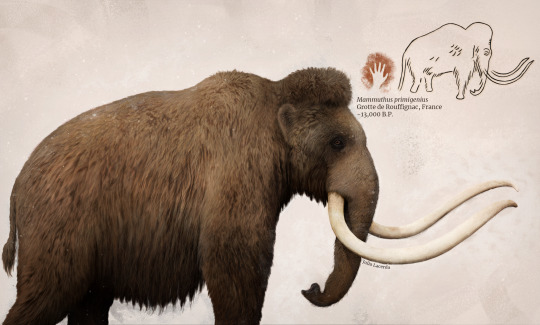
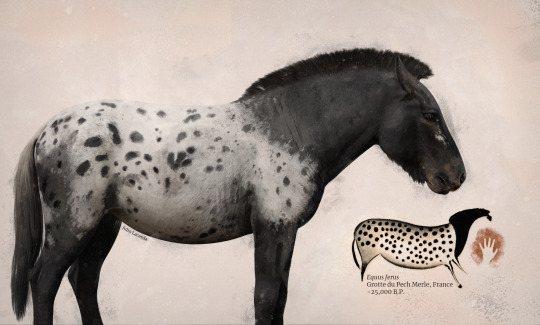
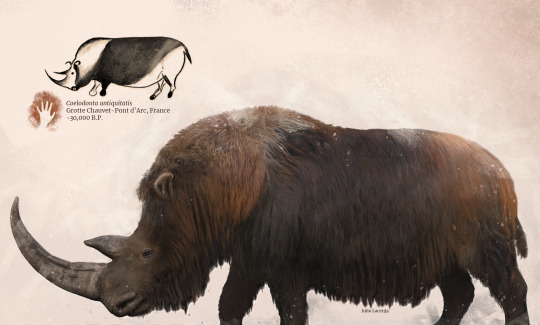

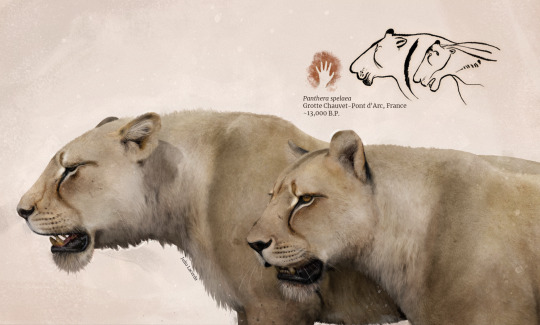



I just realized that apparently I never shared this series here on Tumblr??
I call it Living Paintings, as they are recreations of extinct animals that some artists actually saw and painted from memory, a long time ago.
Patreon • Ko-fi • Facebook • Twitter • Prints & Merch
#palaeoblr#paleoart#cave paintings#mammals#cenozoic#mammuthus#aurochs#horses#coelodonta#moa#cave lion#pelorovis#cave bear#megaloceros
32K notes
·
View notes
Text



Today's random portfolio artwork is "A Fight to the End," based on an amazing fossil of two interlocked Mammuthus columbi skulls. You can read all about this in Locked in Time, by Dean R Lomax and Columbia University Press. By the way, we think the penis is the reason this book is for adults only in Russia!
#Art#Painting#PaleoArt#PalaeoArt#SciArt#SciComm#DigitalArt#Illustration#Dinosaurs#Birds#Reptiles#Palaeontology#Paleontology#Mammoth#Mammuthus
198 notes
·
View notes
Text

Ieva Trinkūnaitė (Lithuanian, 1997) - Endless Nostalgia (2022)
129 notes
·
View notes
Text

Sketches of some Eurasian animals that were part of the famous Pleistocene Megafauna, from bottom to top: Crocuta crocuta spelaea, Bos primigenus, Elamotherium, Ursus spelaeus, and Mammuthus trogontherii
#paleoart#paleontology#pleistocenemegafauna#pleistocene#elasmotherium#cave hyena#cave bear#mammuthus#mammoth#mammal paleontology#mammoths#mammuthus trogontherii#aurochs
79 notes
·
View notes
Text

Mammuthus columbi, the Columbian mammoth, by Zdenek Burian
Well, not exactly. This was supposed to be the imperial mammoth (Mammuthus imperator) when it was painted, but since then imperator has become synonymized with columbi, so you have one warm-weather North American mammoth and one cold-weather North American mammoth.
So that means there are at least two Burian Columbian mammoth pieces. This one is a lot more relaxed and peaceful.
70 notes
·
View notes
Text
Strange Symmetries #22: The Whalerus And The Twisted Tusks
Mammalian tusks usually grow in symmetrical pairs with only minor developmental asymmetry, but a few species have evolved much more uneven arrangements.

Odobenocetops peruvianus was a small toothed whale that lived during the Miocene, about 7-3 million years ago, in shallow coastal waters around what is now Peru. Around 3m long (~10'), it was a highly unusual cetacean with binocular vision, a vestigial melon, muscular lips, and a pair of tusks – features convergent with walruses that suggest it had a similar lifestyle suction-feeding on seafloor molluscs and crustaceans.
In males the right tusk was much more elongated than the left, measuring around 50cm long (~1'8") in this species and up to 1.35m (4'5") in the closely related Odobenocetops leptodon. Since these teeth were quite fragile they probably weren't used for any sort of combat, and they may have instead served more of a visual display function.
And despite being closer related to modern narwhals and belugas than to other toothed whales, Odobenocetops' long right-sided asymmetric tusks actually seem to have evolved completely independently from the iconic left-sided asymmetric spiral tusks of narwhals.
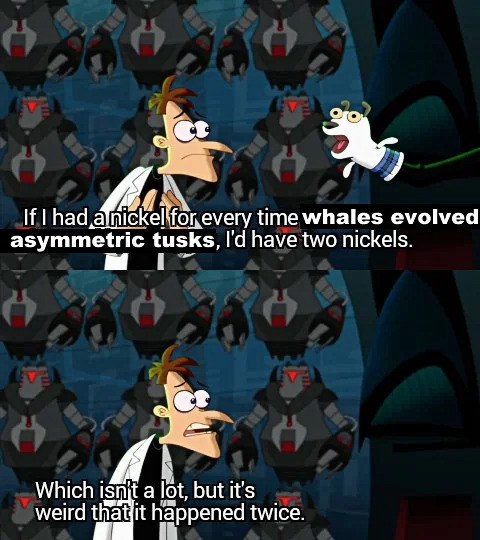
———

The woolly mammoth (Mammuthus primigenius) lived across Eurasia and North America during the last ice age, mostly from the Pleistocene about 400,000 years ago to the early Holocene about 10,000 years ago – altohugh a few relict populations survived until around 4,000 years ago in isolated areas of Alaska, Siberia, and eastern Russia.
Around 3m tall at the shoulder (~10ft), these hairy proboscideans had very long curving tusks that were used for digging out vegetation from under snow and ice, scraping bark from trees, and for fighting.
The tusks showed a lot of variation in their curvature, and were often rather asymmetrical, a condition also seen in the closely related Columbian mammoth. Like modern elephants mammoths may have also favored using one side over the other for certain tasks, which over their lifetimes could result in uneven wear exaggerating the natural asymmetry even more.
———
NixIllustration.com | Tumblr | Twitter | Patreon
#science illustration#strange symmetries#paleontology#paleoart#palaeoblr#tusks#odobenocetops#delphinoidea#odontoceti#toothed whale#cetacean#whale#artiodactyla#ungulate#marine mammal#woolly mammoth#mammuthus#elephant#proboscidea#afrotheria#mammal#art#whalerus#behold‚ a walrus!
346 notes
·
View notes
Text
Mammoths!

Love these big guys. Wanted to draw them playing because I feel that I don't see much paleoart of that.
#mammuthus#mammuthus primigenius#mammoth#ice age#cenozoic#paleoart#paleoblr#quarternary#woolly mammoth#paleontology#nature#yee art
62 notes
·
View notes
Text



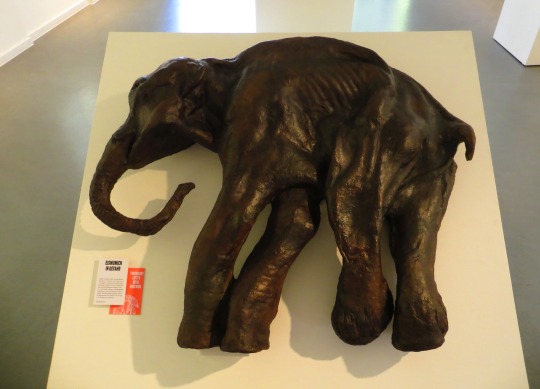


Woolly mammoth (Mammuthus primigenius)
(temporal range: 0.40-0.0037 mio. years ago)
[text from the Wikipedia article, see also link above]
The woolly mammoth (Mammuthus primigenius) is an extinct species of mammoth that lived during the Pleistocene until its extinction in the Holocene epoch. It was one of the last in a line of mammoth species, beginning with the African Mammuthus subplanifrons in the early Pliocene. The woolly mammoth began to diverge from the steppe mammoth about 800,000 years ago in East Asia. Its closest extant relative is the Asian elephant. The Columbian mammoth (Mammuthus columbi) lived alongside the woolly mammoth in North America, and DNA studies show that the two hybridised with each other.
The appearance and behaviour of this species are among the best studied of any prehistoric animal because of the discovery of frozen carcasses in Siberia and North America, as well as skeletons, teeth, stomach contents, dung, and depiction from life in prehistoric cave paintings. Mammoth remains had long been known in Asia before they became known to Europeans in the 17th century. The origin of these remains was long a matter of debate, and often explained as being remains of legendary creatures. The mammoth was identified as an extinct species of elephant by Georges Cuvier in 1796.
The woolly mammoth was roughly the same size as modern African elephants. Males reached shoulder heights between 2.67 and 3.49 m (8.8 and 11.5 ft) and weighed up to 8.2 metric tons (9.0 short tons). Females reached 2.6–2.9 m (8.5–9.5 ft) in shoulder heights and weighed up to 4 metric tons (4.4 short tons). A newborn calf weighed about 90 kg (200 lb). The woolly mammoth was well adapted to the cold environment during the last ice age. It was covered in fur, with an outer covering of long guard hairs and a shorter undercoat. The colour of the coat varied from dark to light. The ears and tail were short to minimise frostbite and heat loss. It had long, curved tusks and four molars, which were replaced six times during the lifetime of an individual. Its behaviour was similar to that of modern elephants, and it used its tusks and trunk for manipulating objects, fighting, and foraging. The diet of the woolly mammoth was mainly grasses and sedges. Individuals could probably reach the age of 60. Its habitat was the mammoth steppe, which stretched across northern Eurasia and North America.
The woolly mammoth coexisted with early humans, who used its bones and tusks for making art, tools, and dwellings, and hunted the species for food. The population of woolly mammoths declined at the end of the Pleistocene, disappearing throughout most of its mainland range, although isolated populations survived on St. Paul Island until 5,600 years ago, on Wrangel Island until 4,000 years ago, and possibly (based on ancient eDNA) in the Yukon up to 5,700 years ago and on the Taymyr Peninsula up to 3,900 years ago. After its extinction, humans continued using its ivory as a raw material, a tradition that continues today. With a genome project for the mammoth completed in 2015, it has been proposed the species could be revived through various means, but none of the methods proposed are yet feasible.
16 notes
·
View notes
Text
2 notes
·
View notes
Text

proboscid kid since day one
#elephant worship#elephant#loxodonta#loxodonta africana#african bush elephant#loxodonta cyclotis#african forest elephant#elephas maximus#asian elephant#mammuthus#mammuthus primigenius#woolly mammoth#proboscidean#mine
2 notes
·
View notes
Text
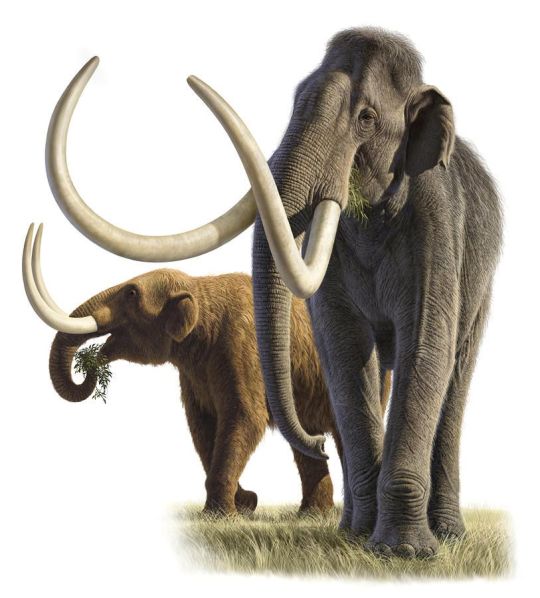
MEGAFAUNA OF NORTH AMERICA -- THE MAMMOTHS OF THE WEST.
PIC INFO: Spotlight on a Columbian mammoth (Mammuthus columbi), a species of mammutidae reportedly much larger and taller than the woolly variety, and a mastodon is in the background. Mastodon's generally had a browsing diet, distinct from that of the contemporary Columbian mammoth, which tended towards grazing. Artwork by Raúl Martín.
EXTINCTION: Both species disappeared from North America as part of a mass extinction of most of the Pleistocene megafauna, widely believed to have been caused by a combination of climate changes at the end of the Pleistocene and overexploitation by Paleo-Indians, c. 11,000 years ago.
Source: https://dinotoyblog.com/forum/index.php?topic=1887.20.
#Columbian Mammoth#Mammutidae#Mammuthus columbi#Mammuthus#Pleistocene Megafauna#Megafauna#Mammoth#Mastodon#Holocene#Prehistoric Animals#Prehistoric Beasts#Prehistory#Prehistoric#Mammoths#Palaeo Art#Paleo Art#Proboscideans#Elephantidae#Prehistoric Elephants#Pleistocene Epoch#Mega Mammals
4 notes
·
View notes
Photo

“Violence for Violence is the rule of beasts”
Woolly mammoths
Patreon • Ko-fi • Facebook • Twitter • Prints & Merch
697 notes
·
View notes
Photo

Treballant amb espectadors. #naturkundemuseumstuttgart #stuttgart #löwentormuseum #naturalhistorymuseum #mamut #mammoth #mammuthus #mamuthusprimigenius #mammuth (at Staatliches Museum für Naturkunde Stuttgart) https://www.instagram.com/p/CmHYOBqMkLE/?igshid=NGJjMDIxMWI=
#naturkundemuseumstuttgart#stuttgart#löwentormuseum#naturalhistorymuseum#mamut#mammoth#mammuthus#mamuthusprimigenius#mammuth
5 notes
·
View notes
Text

Trunk in the chokepoint.
#gaming#virtual photography#far cry#far cry primal#woolly mammoth#mammoth#Mammuthus#mammuthus primigenius
1 note
·
View note
Text

Mammuthus columbi, the Columbian mammoth, by Zdenek Burian.
Probably one of my favorites from Burian’s elephants. I love the sense of motion and action, the size and majesty of the rearing mammoth, and the microstory it seems to be telling.
755 notes
·
View notes
Text

The boy woke up from his nap, awakened by a strange sensation. Something strong and hairy was snuffling him, making him slightly ticklish. There was also a strong smell. It wasn’t a bad smell, but a smell large, hairy animals have. Strong and musky, very earthy and a bit of something that burns your nostrils.
Realising that something was wrong, the boy woke up with a start, and almost screamed in surprise. The adolescent mammoth stood over him, curiously eyeing this strage being before walking away, back to her family.
Needless to say, the boy would never forget that awakening.
#paleoart#palaeoblr#stylized paleoart#mammoth#woolly mammoth#mammuthus primigenius#palaeo cartoon#anthropology#neolithic#ice age
259 notes
·
View notes